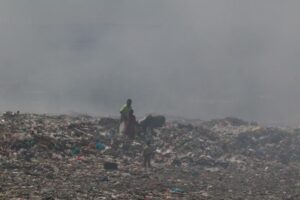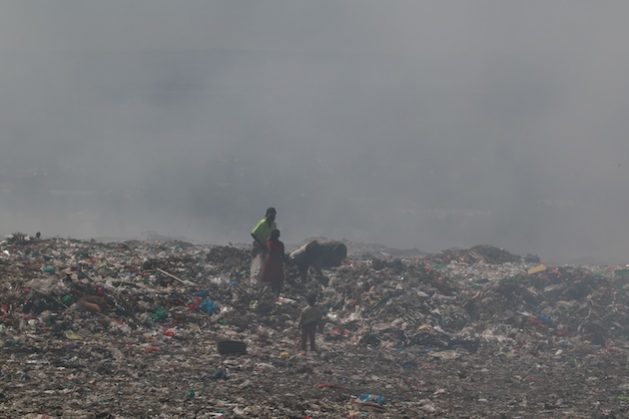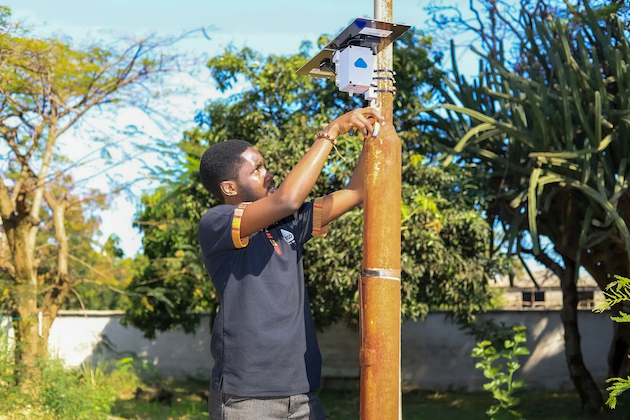
Africa, Climate Action, Conferences, Development & Aid, Environment, Featured, Headlines, Health, Sustainable Development Goals, TerraViva United Nations

A mother and her children are seen wading through a cloud of smoke at the Dandora dumpsite, Kenya’s largest open landfill. Smoke emanating from the dumpsite is cited as a contributor to air pollution in Nairobi. Credit: Jackson Okata/IPS
– Deborah Adhiambo (43) has been battling mild asthma since 2022, a condition she describes as “both a health and economic burden.’’ The mother of three lives within Dandora Estate, nine miles east of Kenya’s capital, Nairobi. Dandora is home to Kenya’s largest open landfill, which receives more than 2,000 metric tonnes of waste daily.
For five years, Adhiambo operated a makeshift restaurant near the dumpsite, where her main clients were waste pickers working within its environs.
“Working near the dumpsite exposed me to the heavy smoke that billows from the dumpsite. I started developing chest pains gradually and would take painkillers to subdue the pain. It was later that I was diagnosed with asthma,’’ Adhiambo told IPS.
Adhiambo’s doctors told her that prolonged and constant exposure to toxic fumes was the root cause of her asthma. She was forced to close her business since she could not venture out of her house early in the morning, late in the evenings or during cold seasons.
“The closure of my business due to sickness crippled me economically as it was my only source of income. Getting medication and feeding my family has been hard because now I have to rely on my husband, who also works at the dumpsite,” she says.
Nairobi’s Air Quality
More than 70 percent of Nairobi’s 5.3 million residents live in informal settlements like Dandora, which analysts say have the worst air quality, with vulnerable populations, particularly women and children, bearing the brunt of polluted air. Vehicles, open burning of waste, and industrial emissions are cited as the major sources of air pollutants in Nairobi. Motor vehicles contribute an estimated 40 percent of Nairobi’s particulate matter (PM2.5) air pollution concentrations, with illegal dumping and open waste burning contributing 25 percent.
And as both the population and economic output of Kenya’s capital keep expanding, the demand for energy from fossil fuels is also on the rise. The rapid expansion of Nairobi has taken an environmental toll on the city, which is evident in the worsening air pollution levels. Air pollution in Kenya’s capital is 4.2 times higher than the World Health Organization’s (WHO) recommended average annual concentration levels.
According to the World Health Organization, Nairobi’s air pollution is 2.4 times higher than recommended levels, with 19,000 poor air quality deaths being reported in Kenya annually.

A technician installs a low-cost air quality monitor sensor in Nairobi, Kenya. Air quality monitors are helping Nairobi collect data on air pollution. Credit: Jackson Okata/IPS
Tech and Data
To enhance her efforts in combating air pollution, the City of Nairobi has been incorporating the use of technology. The city management has been installing low-cost air quality monitors and sensors to gather and share data on the levels of air pollution trends across the city. The data collected is then analyzed and guided in the formulation of policies and legal frameworks to combat air pollution, even as East Africa’s economic giant works towards realizing her ambitious target of becoming a net-zero green city by 2030.
Dubbed AirQo monitors, the low-cost air quality sensors developed by a team of young engineering and computer science students at Uganda’s Makerere University are in use in eight countries, including Kenya.
Engineer Bainomugisha, an Associate Professor of Computer Science at Makerere University and lead developer of the AirQo monitoring system, says Sub-Saharan Africa lacks usable air quality data that can help in the formulation of proper and effective policies to combat air pollution. AirQo monitors collect information about air pollution levels, types of air pollutants, and air quality
Bainomugisha explains that the air quality monitors main aim is to “close the existing gap in air quality monitoring.” AirQo air quality monitors collect air samples, which are then analyzed through a light scattering technology that quantifies the particulate matter concentration.
The information is then relayed to a cloud-based network that determines the pollution levels in a specific area. The devices measure the air particulate matter PM2.5 and PM10, which is a mixture of solid particles in the air. They also capture ambient meteorological conditions such as humidity and atmospheric pressure
“The air quality monitors run on a 2G GSM-enabled network configuration for loT sim cards and are optimized to work in areas with unstable internet and power connectivity,” says Gideon Lubisia, AirQo’s international operations embedded systems and network support engineer.
AirQo has also developed a mobile app that allows people to receive periodic and real-time updates on the air quality in their city. The monitors are mounted at strategic points within the city’s Central Business District, industrial areas, markets, along major city highways and in select residential areas. while others are mounted on motorbikes that move from one location to another, collecting data.
Data and Policy Formulation
With the monitors in place, Nairobi City has been able to develop two air quality collocation installations and infrastructure reference grade monitors, according to Nairobi City County Deputy Director in Charge of Air Quality and Climate Maurice Kavai.
“The one-stop center collocation enables our research teams to compare air quality data collected from various points within the city, which is key in developing appropriate action,” Kivai explained.
“The availability of periodic data collected by the monitors enables the city to establish the extent of pollution in particular areas, identify the causes, and develop necessary actions,” he said.
Through air quality data collected through the monitors and establishing the extent of air pollution in the city, Nairobi has been able to develop a city Air Quality Action Plan as well as enact the Nairobi City County Air Quality Act which have become critical policy and legal assets in tackling the problem of air pollution.
AirQo monitors are now in use within select cities in eight African countries, including Uganda, Kenya, Nigeria, Cameroon, Burundi, Ghana, Mozambique, and Senegal.
Global Push for Clean Air
During the Climate and Clean Air Conference(CCAC) 2024 in Nairobi between February 21 and 23, 2024, ahead of the sixth session of the UN Environment Assembly (UNEA-6), member states and partners launched a Clean Air Flagship effort to provide, among other things, data-led policy action towards combating air pollution
Inger Andersen, UNEP’s Executive Director, said, “We need to push harder on superpollutants. Just as you need a superhero to defeat a supervillain, we need super solutions to face down super pollutants. And we need you to mastermind these solutions.”
Speaking on the sidelines of the CCAC, Kenyan environmentalist Elizabeth Wathuti observed that “the very essence of life starts with a breath, a gasp of air that signifies the beginning of our journey on this Earth. Yet, for too many across our globe, this fundamental act of breathing has become a hazard, a risk, and a gamble against the odds of pollution and climate-induced adversities.” According to Wathuti, the commitment to clean air and a stable climate is not just an environmental cause but a fight for the very right to life.
The World Health Organization estimates that 99 percent of the world’s population lives in places with poor air quality, leading to nearly seven million premature deaths per year, primarily in low- and middle-income countries.
According to UNEP, in Africa alone, ambient air pollution caused an estimated 400,000 premature deaths in 2019, while indoor air pollution caused more than one million premature deaths in the same year. Some of the leading air pollution-related ailments that contribute to these premature deaths include pneumonia, heart disease, stroke, diabetes, chronic lung disease, and lung cancer. Ambient air pollution and household air pollution are associated with 6.7 million premature deaths annually.
IPS UN Bureau Report
